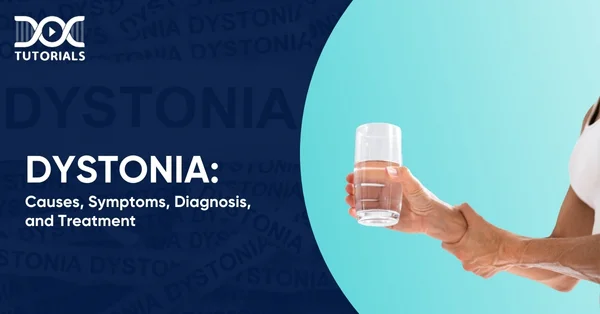Dystonia | Causes, Symptoms, Diagnosis, Treatment, and More

Dystonia is a neurological movement disorder that disrupts normal muscle control, resulting in involuntary and prolonged muscle contractions. They may lead to repetitive and pattern-like movements or abnormal postures, often resulting in discomfort or pain.
The condition may occur on any part of the body, such as the eyelids, face, neck, hands, legs, etc. Moreover, the appearance and severity of dystonia vary significantly depending on which areas are involved. Alongside motor symptoms, many individuals with dystonia also experience non-motor issues such as depression and anxiety, which may affect their overall quality of life.
As a NEET PG candidate, you need to learn more about the causes, clinical presentation, diagnosis, and treatment of dystonia. In clinical practice, this knowledge enhances the accuracy of diagnosis and facilitates effective patient management.
Continue reading to acquire a complete understanding of this major neurological condition.
What are the Causes of Dystonia?
In most instances, dystonia does not have an identifiable cause. This condition is believed to be linked to dysfunction in the basal ganglia a region of the brain responsible for controlling muscle contractions. The issue lies in how the nerve cells in this area communicate with each other.
Dystonia is typically classified into three main types, which are as follows:
- Genetic Dystonia
Genetic forms of dystonia arise due to inherited abnormalities in specific genes. A number of gene mutations have been linked to dystonia of different kinds:
- DYT1: This mutation leads to DYT1 dystonia, a rare condition that typically emerges in childhood. It usually begins in the limbs and can result in significant disability.
- DYT3: Alterations in this gene have been connected to symptoms such as tremors, muscular rigidity, and slowness of movement, resembling those seen in Parkinson’s disease.
- DYT5: Mutations here may cause dopa-responsive dystonia (also known as Segawa’s disease). Symptoms often start in early life, tend to intensify with physical exertion or as the day progresses, and generally respond well to levodopa, a drug commonly used to manage Parkinson’s disease.
- DYT6: Genetic changes involving this gene may result in dystonia affecting the head, neck, and upper limbs.
- DYT11: This gene is linked to episodes of sudden, brief muscle jerks, known as myoclonus.
- DYT12: Mutations in this gene can lead to rapidly developing dystonic symptoms that resemble those found in Parkinson’s disease.
- DYT28: This gene is associated with childhood-onset dystonia.
- Acquired Dystonia
Also referred to as secondary dystonia, acquired dystonia results from damage to the basal ganglia. It may occur due to various underlying factors, including:
- Traumatic brain injury
- Stroke
- Brain tumours
- Oxygen deprivation, particularly during birth
- Certain infections
- Exposure to toxic substances such as carbon monoxide or heavy metals like lead
- Adverse drug reactions
When dystonia arises as a side effect of medication, it is termed tardive dystonia. This form is often temporary and can generally be managed with appropriate treatment.
In contrast to genetic dystonia, acquired dystonia typically affects a single region of the body and is less likely to spread to other areas.
- Idiopathic Dystonia
Idiopathic dystonia refers to cases where the cause remains unknown. Many forms of dystonia fall into this category, developing without any identifiable genetic or environmental trigger.
What are the Symptoms of Dystonia?
Dystonia presents differently in each person. In this regard, muscle spasms may occur in the following manner:
- It starts with a specific body part, such as the arm, leg, or neck. When focal dystonia begins after the age of 21, it commonly affects the face, arm, or neck and may stay localised or gradually spread to adjacent areas.
- Happens only during particular tasks, like handwriting.
- Intensifies due to stress, tiredness, or anxiety.
- Becomes increasingly visible over time.
Various parts of the body may show the following symptoms:
- Hand and Forearm (Task-Specific Dystonia)
Some individuals develop symptoms only during repetitive actions such as writing or playing an instrument. Known as writer’s dystonia or musician’s dystonia, these spasms usually subside when the arm is at rest.
- Eyelids (Blepharospasm)
Involuntary blinking or eyelid spasms may make it difficult to keep the eyes open. Although typically painless, symptoms can worsen in bright light or while reading, watching television, or engaging in conversation. Some individuals may also experience dryness, irritation, or sensitivity to light.
- Jaw and Tongue (Oromandibular Dystonia)
This form of dystonia affects speech and eating. It can lead to slurred speech, drooling, and difficulty with chewing or swallowing. Pain is a common feature, and it often appears alongside cervical dystonia or blepharospasm.
- Neck (Cervical Dystonia)
When neck muscles contract involuntarily, the head may turn or tilt to one side or pull forward or backward. This condition can also cause discomfort or pain.
- Voice Box and Vocal Cords (Laryngeal Dystonia)
This affects speech by altering the function of the vocal cords, resulting in a strained or whisper-like voice.
What are the Risk Factors of Dystonia?
Recognising the risk factors linked to dystonia plays an important role in identifying possible causes and improving prevention efforts. Though the precise cause remains unclear, several contributing factors have been identified through research:
- Genetic Predisposition
Individuals with a family history of dystonia face a higher risk of developing the condition. Specific gene mutations and variants have been linked to an increased susceptibility, suggesting a strong genetic component.
- Age of Onset
Dystonia can appear at any stage of life, but it more frequently begins in childhood or early adulthood. Early-onset primary dystonia, in particular, is more common among younger individuals.
- Medication Use
Drugs prescribed for psychiatric illnesses or nausea, especially antipsychotics and antiemetics, have been linked to drug-induced dystonia. These medications may trigger abnormal muscle movements in susceptible individuals.
- Associated Medical Conditions
Certain health disorders, such as Parkinson’s disease and Wilson’s disease, are known to raise the risk of developing secondary dystonia.
- No Clear Risk
In some cases, people with no identifiable risk factors still develop dystonia, indicating that other unknown factors may be involved.
How to Diagnose Dystonia?
There are a number of diagnostic tests recommended by healthcare professionals to diagnose dystonia, such as:
- Genetic Testing
As certain types of dystonia are linked to specific genetic mutations, these tests can support diagnosis and give personalised treatment planning.
- Blood and Urine Tests
These tests help detect the presence of toxins or any medical conditions that might contribute to dystonia.
- MRI or CT Scan
Brain imaging techniques, such as magnetic resonance imaging (MRI) or computed tomography (CT), are used to identify abnormalities, including tumours or signs of a stroke.
- Electromyography (EMG)
EMG evaluates the electrical activity of muscles, providing valuable insight into abnormal muscle function.
What are the Treatment Options for Dystonia?
The dystonia treatments depend on the type and severity of the condition. They are as follows:
- Medication
Medicines are frequently prescribed to regulate activity levels in muscles. These may include:
- Dopaminergic stimulants such as tetrabenazine (Nitoman) and levodopa (Sinemet) affect the dopamine levels of the brain.
- Anticholinergic drugs like procyclidine hydrochloride (Kemadrin), benztropine (Cogentin), and trihexyphenidyl (Artane), work by blocking the action of acetylcholine.
- GABAergic drugs such as lorazepam (Ativan), baclofen, diazepam (Valium), and clonazepam (Klonopin), help regulate gamma-aminobutyric acid (GABA) in order to minimise the spontaneous activity of the muscles.
- Injections of botulinum toxin help weaken overactive muscles. These are injections administered by medical practitioners and are normally repeated every three months.
- Surgical Intervention
In cases where these medicines fail, medical practitioners can think of surgery:
- Deep Brain Stimulation (DBS) procedure is a measure where a patient has electrodes inserted into specific regions of their brain and attached to a pulse generator placed on the chest. The device sends electrical impulses that aid in controlling abnormal muscular contractions.
- Less invasive methods used in surgery include removing the nerve or lesioning the areas of the brain that cause dystonia, though this is not as commonly done.
- Rehabilitative Therapies
Supportive therapies often form a key part of a holistic treatment plan:
- Occupational therapy helps individuals become independent in their day-to-day life, such as dressing, eating meals, and performing other activities, particularly when fine motor skills have been affected.
- Speech and voice therapy can help patients with laryngeal dystonia as it helps to control the muscles responsible for speech.
- Physical therapy involves specific exercises to achieve strength, flexibility, and motor progress. Tailored programs are drawn based on the muscles involved.
- Alternative and Complementary Therapies
Though such therapies are not considered a cure for dystonia, it is believed that they may provide relief from symptoms and improve the quality of life. They may include:
- Deep breathing, which may involve meditation or other relaxation techniques, can help lower the severity and frequency of attacks by reducing stress.
- Yoga and pilates may improve balance, strength, and posture.
- Biofeedback is when one works with a therapist to observe the responses of the body and learns how to relax the muscles through instantaneous responses.
FAQs About Dystonia
- Which is the most common form of dystonia?
One of the common forms which involves the neck muscles is cervical dystonia. It makes one twist or turn their head unconsciously.
- Can dystonia be cured?
There is currently no cure for dystonia. Nevertheless, various treatments can help manage symptoms and improve quality of life.
- How is dystonia diagnosed?
Clinical diagnosis of dystonia is done through MRI and EMG. In some cases, genetic testing is also conducted.
Conclusion
It is essential for NEET aspirants to have a comprehensive understanding of dystonia, including its causes, symptoms, diagnostic tests, and treatment options. This plays a vital role in both clinical management and exam preparation. A timely diagnosis and effective treatment can significantly improve a person’s health and minimise complications.
DocTutorials offers concise notes, high-yield video lectures, and expert-led guidance to support your preparation and help you secure a top rank. Start your NEET PG journey with DocTutorials and move forward with confidence!
Latest Blogs
-

NEET SS Exam 2024: Analysis, Key Dates, Counselling
The NEET SS 2024 exam kicked off on March 29, 2025. Over two days and two slots, candidates across 13…
-

NEET PG Registration 2025: An Essential Guide For Exam Prep
The NEET PG registration, which is conducted online, is a crucial step in the exam process. Filling out the NEET…
-

NEET PG Syllabus 2026: A Must-Have Complete Guide for Exam Success
The NEET PG Syllabus acts as one of the foundation stones for aspiring postgraduate medical students like you who are…




